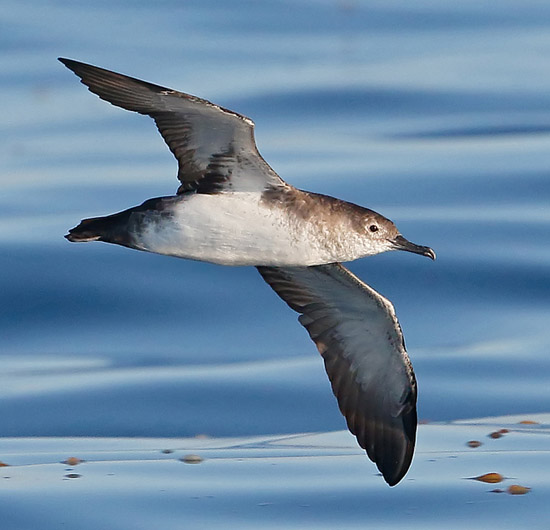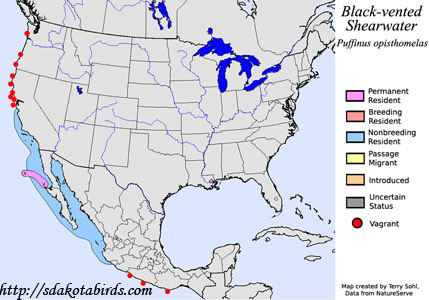Black-vented Shearwater
Puffinus opisthomelas
| Length: 12-15 inches | Wingspan: 30-35 inches | Seasonality: Non-resident in South Dakota |
| ID Keys: Brownish upperparts with light underparts, brown undertail coverts, white underwings with brown trailing edge | ||
 The
Black-vented Shearwater is a species of the eastern Pacific, nesting on
islands off of western Baja California, with non-breeding birds spread
across the eastern Pacific from California southward to coastal Mexico.
While a pelagic species, they come closer to shore than many shearwaters and
in range are commonly seen on pelagic bird tours. They are named for the
dark undertail coverts, a feature that distinguishes them from other
shearwater species that have light-colored undertail coverts.
The
Black-vented Shearwater is a species of the eastern Pacific, nesting on
islands off of western Baja California, with non-breeding birds spread
across the eastern Pacific from California southward to coastal Mexico.
While a pelagic species, they come closer to shore than many shearwaters and
in range are commonly seen on pelagic bird tours. They are named for the
dark undertail coverts, a feature that distinguishes them from other
shearwater species that have light-colored undertail coverts.
Habitat: The few islands on which Black-vented Shearwaters breed are generally dry with either barren sandy soil in which nesting burrows are built, or with deep rocky crevices that serve as nesting sites. Pelagic outside of the breeding season, although they are often found relatively close to shore.
Diet: Feeds on small fish, squid, and crustaceans.
Behavior: Black-vented Shearwaters feed by plunging into the water while in flight, or by making dives from a floated position on the water. They will also feed from flight, dipping down and skimming prey items at or near the surface. They are mostly nocturnal around their breeding colonies.
Nesting: Black-vented Shearwaters are colonial nesters, returning each year to traditional nesting sites on Islas San Benito, Islas Natividad, and Isla de Guadalupe off the coast of western Baja California. The nest is a burrow built in sandy soil, or a deep rocky crevice. A single egg is laid, with both parents helping to incubate the egg. The incubation period is approximately 50 days, with both parents helping to raise the young. Young fledge after about 70 days.
Song: On breeding colonies, nighttime calls similar to haunting wails are heard. They are usually silent away from breeding sites.
Migration: Breeds in a select number of islands off the coast of Baja California. Movements outside of the breeding season are erratic. They can be found off the coast of southern California in any season, but become more numerous in the fall and winter. Other movements are poorly understood. Water temperature may play a key role in non-breeding bird movements, with birds following sea surface temperatures that are suitable for their preferred prey items.
Interactive eBird map: Click here to access an interactive eBird map of Black-vented Shearwater sightings
Similar Species: Once considered a subspecies of the Manx Shearwater, that is the species it is most likely to be confused with visually, but the Manx Shearwater is a bird of the Atlantic Ocean. Also similar to Audubon's Shearwater, but that species too is found in the Atlantic and not the Pacific.
Conservation Status: Introduced predators on breeding islands, particularly rats and cats, have directly influenced nesting success and overall populations. Overall populations strongly declined from historical levels, but eradication of cats from its primary breeding island, Natividad, have resulted in a stabilization of populations. Cats, dogs, rats, and other predators continue to be a threat on other breeding islands, and as a result, up to 90% of the world's population breeds on Natividad. Given the small breeding range, continued threats from introduced predators, and that the population is so reliant on one breeding site, the IUCN has listed the Black-vented Shearwater as "near threatened".
Further Information: 1) Audubon Guide to North American Birds - Black-vented Shearwater
2) BirdLife International - Black-vented Shearwater
3) WhatBird - Black-vented Shearwater
Photo Information: Photo taken October 11th, 2015 off the coast of San Diego, California - Photo taken by Julio Mulero - Photo licensed under Creative Commons Attribution NonCommercial NoDerivs 2.0 Generic License
| Click below for a higher-resolution map |
 |
| South Dakota Status: Non-resident in South Dakota |
Additional Black-vented Shearwater Photos (coming soon!!)
